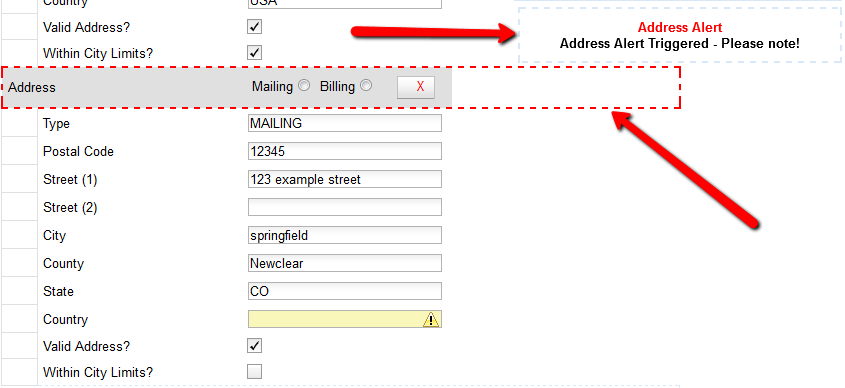 |  | ||
| HomePrev | Chapter 37. Circulation timesavers and workflows | Next | |
|---|---|---|---|
The Address Alert module gives administrators the ability to notify staff with a custom message when addresses with certain patterns are entered in patron records.
This feature only serves to provide pertinent information to your library system’s circulation staff during the registration process. An alert will not prevent the new patron account from being registered and the information will not be permanently associated with the patron account.
To access the Address Alert module, select Administration → Local Administration → Address Alerts.
You must have Local Administrator permissions or ADMIN_ADDRESS_ALERT permission to access the Address Alert module.
Each address alert is tied to an Org Unit and will only be matched against staff client instances of that Org Unit and its children.
When viewing the address alerts you will only see the alerts associated with the specific org unit selected in the "Context Org Unit" selection box. You won’t see alerts associated with parent org units, so the list of alerts isn’t a list of all alerts that may effect your org unit, only of the ones that you can edit.
The specific permission that controls access to configuring this feature is ADMIN_ADDRESS_ALERT. Local Administrator level users will already have this permission. It is possible for the Local Administrator to grant this permission to other staff.
How to add an address to the alert list:
A form will open with the following fields to fill out:
Table 37.2. New Address Alert Fields
Field | Description |
Owner | Which Org Unit owns this alert. Set this to your system or branch. |
Active | Check-box that controls if the alert is active or not. Inactive alerts are not processed. |
Match All Fields | Check-box that controls if all the fields need to match to trigger the alert(checked), or only at least one field needs to match(unchecked). |
Alert Message | Message that will be displayed to staff when this alert is triggered. |
Street (1) | Street 1 field regular expression. |
Street (2) | Street 2 field regular expression. |
City | City regular expression. |
County | County regular expression. |
State | State regular expression. |
Country | County regular expression. |
Postal Code | Postal Code regular expression. |
Address Alert ID | Displays the internal database id for alert after the alert has been saved. |
Billing Address | Check-box that specifies that the alert will only match a billing address if checked. |
Mailing Address | Check-box that specifies that the alert will only match a mailing address if checked. |
To make changes to an existing alert, double click on the alert in the list. The editing form will appear, make your changes and click save or cancel when you are done.
If you don’t see your alerts, make sure the "Context Org Unit" selection box has the correct Org Unit selected.
To delete an alert or many alerts, click the selection check-box for all alerts you would like to delete. Then click the "Delete Selected" button at the top of the screen.
When an Address Alert is triggered by a matching address the staff will see the address block highlighted with a red dashed line, along with an "Address Alert" block which contains the alert message.
Here is an example of what staff would see.

All of the patterns entered to match the various address fields are evaluated as case-insensitive regular expressions by default.
Address Alerts use POSIX Regular Expressions included in the PostgreSQL database engine. See the PostgreSQL documentation for full details.
If you want to do a case-sensitive match you need to prepend the pattern with "(?c)"
The simplest regular expression that acts as a wildcard is ".*", that matches any type of character zero or more times.
Apartment address. Match an apartment address to prompt for unit number.
All addresses on street. Match all addresses on a certain street. Matches ave and avenue because of ending wildcard.
Match list of cities. Match several different cities with one alert. Could be used if certain cities don’t have reciprocal agreements. Note the use of parentheses and the | character to separate the different options.
Links to resources with more information on how and why this feature was developed and where the various source files are located.